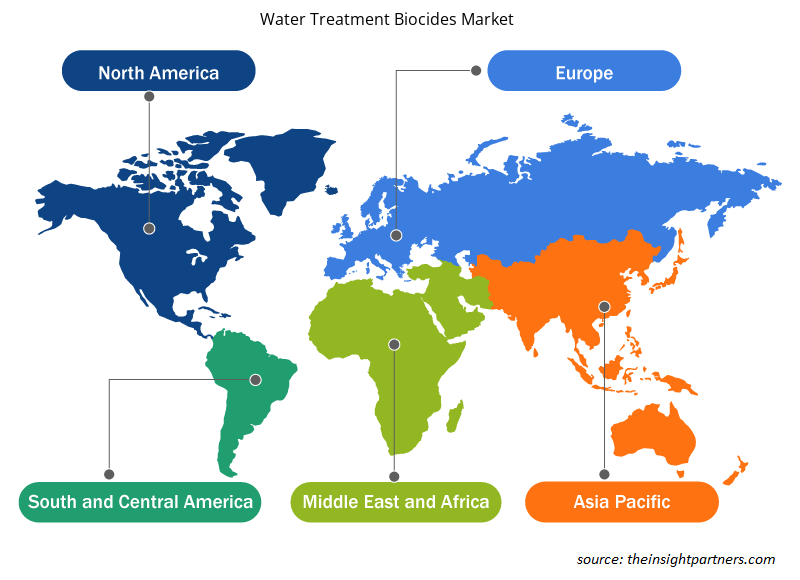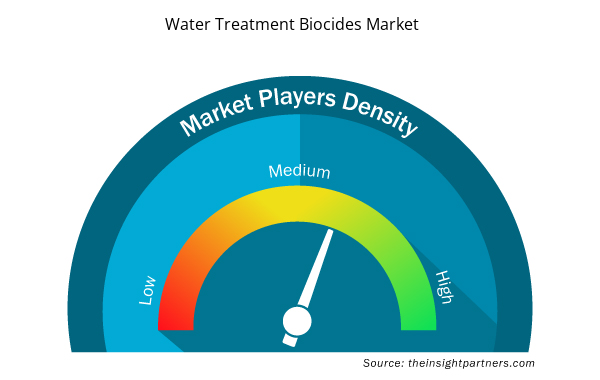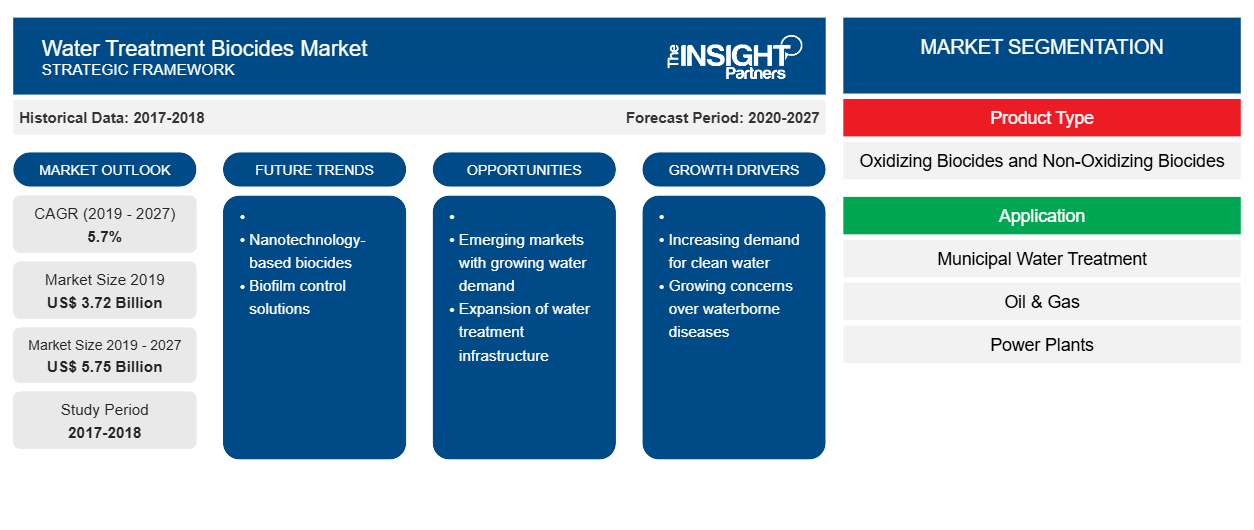2019 年水处理杀菌剂市场规模为 37.2367 亿美元,预计2020 年至 2027 年的复合年增长率为 5.7%,到 2027 年达到 57.5443 亿美元。
水处理杀菌剂主要用于控制水体中的微生物生长。水处理杀菌剂在石油和天然气、发电厂、采矿、纸浆和造纸、市政水处理、游泳池等各种应用中的使用日益增多,预计将推动市场增长。由于不受控制的微生物生长,会出现并发症,包括化学物质分解、健康危害、生物膜形成、传热损失、流动受限和沉积物腐蚀。因此,人们对水处理体应用的认识不断提高,引发了全球市场的激增。
所研究的北美地区市场预计在预测期内以 5.9% 的最高复合年增长率增长。该地区水处理杀菌剂市场的增长主要归因于生产水处理杀菌剂所需的原材料数量巨大且易于获得。北美工业部门的扩张导致水体受到化学毒素和废水沉积的污染增加。美国农业部已批准在水处理中使用杀菌剂,用于市政水处理、石油和天然气、发电厂、纸浆和造纸、采矿、游泳池等各种用途。目前工业部门的扩张,特别是原油和其他石油和天然气工厂的扩张,进一步推动了北美地区水处理杀菌剂市场的发展。美国对中国化学品进口征收的关税不断增加,有可能抵消美国化学品生产商享有的低成本优势。市政水处理、石油和天然气、发电厂、纸浆和造纸、采矿、游泳池等应用日益增多,推动了北美水处理杀菌剂市场的发展。随着水处理杀菌剂应用的不断增加以及水处理应用的发展和创新,预计未来几年北美地区的水处理杀菌剂市场将蓬勃发展。
定制此报告以满足您的需求
您可以免费定制任何报告,包括本报告的部分内容、国家级分析、Excel 数据包,以及为初创企业和大学提供优惠和折扣
- 获取此报告的关键市场趋势。这个免费样品将包括数据分析,从市场趋势到估计和预测。
COVID-19 对水处理 杀菌剂市场的影响
截至 2021 年 7 月,美国、印度、巴西、俄罗斯、西班牙、法国、英国、土耳其和意大利是确诊病例和报告死亡人数最多的国家。由于封锁、旅行禁令和企业停工,COVID-19 正在影响不同国家的经济和多个行业。各种制造工厂的关闭也受到了影响,全球供应链也对全球市场上的商品制造、交付时间表和销售产生了负面影响。此外,欧洲、亚太地区和北美国家进一步实施的全球旅行禁令也影响了商业合作和伙伴关系机会。
由于新冠疫情,化学品和材料行业也面临巨大损失,这进一步影响了世界经济。它进一步扰乱了运输系统,扰乱了原材料的供应。破坏性的价值链对原材料供应产生了负面影响,进而影响了甜菊糖市场的增长。然而,随着各经济体计划恢复运营,终端用户行业对水处理杀菌剂的需求预计将上升。此外,化学品和材料生产公司也在采取一些安全措施来对抗冠状病毒,其中包括限制与送货员和访客的直接接触、加强和传播适当的卫生习惯、进行彻底的卫生处理和消除换班期间的人员接触。考虑到所有这些因素,可以推测,在疫情后,对这些产品的需求将大幅增加。
市场洞察
北美水处理杀菌剂需求激增
预计在预测期内,北美将占据水处理杀菌剂市场的最大份额。杜邦、艺康公司、索理思以及美国雅宝公司等知名制造商在该地区的存在对市场产生了积极影响。由于美国现有的水和废水处理装置老化,美国环境保护署 (USEPA)主要强调改善供水和污水处理服务,特别是在市政废水处理方面。水处理领域需求的增长,以及建筑业复苏需求的增长,可能会推动北美水处理杀菌剂市场的发展。该地区的不同发达国家都有极其严格的安全规范,公民必须遵守。北美被进一步推定为水处理杀菌剂最大的地区,因为该地区有多家制造商专门从事几乎所有行业,例如食品和饮料、水净化以及油漆和涂料,所有这些行业都是杀菌剂的最大消费者。此外,北美石油和天然气产量的增加是推动该应用领域市场发展的另一个主要因素。该国强有力的州级和国家级市政法规进一步对市场产生了积极影响。
产品类型洞察
根据产品类型,全球水处理杀菌剂市场分为氧化性杀菌剂和非氧化性杀菌剂。氧化性杀菌剂在 2019 年占据水处理杀菌剂市场的最高市场份额。氧化剂(如氯)会吸收电子;同时,它攻击的细菌会失去电子。这种电子损失进一步导致生物体死亡或至少阻止其继续生长周期。氧化性杀菌剂也可以连续或间歇地喂食。对于几乎没有或完全没有现有微生物污染的系统,通常建议连续喂食氧化性杀菌剂。如果连续剂量喂食并得到正确管理,它将需要最少的维护,也是最安全的处理形式。根据氧化杀菌剂在水中的含量、与水的反应方式、与水中不同化合物的反应方式、其稳定性、其穿透生物膜的能力、其氧化能力以及其有效性,存在差异。
应用程序洞察
根据应用,水处理杀菌剂市场细分为市政水处理、石油和天然气、发电厂、纸浆和造纸、采矿、游泳池等。2019 年,石油和天然气部门占据了全球水处理杀菌剂市场的最大份额。石油和天然气行业使用多种杀菌剂。丙烯醛是一种高反应性分子,用于在油田中发挥多种不同的功能。它在低使用浓度下也是一种有效的杀菌剂,并将进一步降低硫化氢浓度。它再次用于挤压处理,主要用于帮助溶解硫化铁。溴硝醇是一种卤代二醇,也含有亲电碳原子。它主要用于流体保存应用,在压裂液或其他 pH 值为中性至弱碱性的流体的保存中非常显着。溴硝醇对假单胞菌有效。
并购和研发是企业扩大全球业务范围的常用策略,这进一步影响了市场规模。水处理杀菌剂市场的参与者一直在实施上述策略,以扩大客户群并在全球市场中获得显著份额,这也使他们能够在全球范围内保持自己的品牌知名度。
报告亮点
- 全球水处理杀菌剂市场的渐进式行业趋势,帮助参与者制定有效的长期战略
- 发达市场和发展中市场公司采用的业务增长战略
- 2017 年至 2027 年全球水处理杀菌剂市场定量分析
- 各行业对全球水处理杀菌剂需求的估计
- PEST 分析阐明了水处理杀菌剂生态系统中买家和供应商的有效性
- 了解竞争激烈的市场形势和全球水处理杀菌剂需求的最新发展
- 市场趋势和前景,以及推动和抑制全球水处理杀菌剂市场增长的因素
- 通过了解支撑全球水处理杀菌剂市场增长商业利益的战略,帮助制定决策
- 全球水处理杀菌剂市场规模(按市场各个节点)
- 全球水处理杀菌剂市场的详细概述和细分,以及水处理杀菌剂行业动态
- 全球水处理杀菌剂市场各地区规模及增长机遇
水处理杀菌剂市场区域洞察
Insight Partners 的分析师已详细解释了预测期内影响水处理杀菌剂市场的区域趋势和因素。本节还讨论了北美、欧洲、亚太地区、中东和非洲以及南美和中美洲的水处理杀菌剂市场细分和地理位置。

- 获取水处理杀菌剂市场的区域特定数据
水处理杀菌剂市场报告范围
| 报告属性 | 细节 |
|---|---|
| 2019 年市场规模 | 37.2亿美元 |
| 2027 年市场规模 | 57.5亿美元 |
| 全球复合年增长率(2019 - 2027) | 5.7% |
| 史料 | 2017-2018 |
| 预测期 | 2020-2027 |
| 涵盖的领域 | 按产品类型
|
| 覆盖地区和国家 | 北美
|
| 市场领导者和主要公司简介 |
|
水处理杀菌剂市场参与者密度:了解其对业务动态的影响
由于消费者偏好的不断变化、技术进步以及对产品优势的认识不断提高等因素,最终用户需求不断增加,推动了水处理杀菌剂市场快速增长。随着需求的增加,企业正在扩大其产品范围,进行创新以满足消费者需求,并利用新兴趋势,从而进一步推动市场增长。
市场参与者密度是指在特定市场或行业内运营的企业或公司的分布情况。它表明在给定市场空间中,相对于其规模或总市场价值,有多少竞争对手(市场参与者)存在。
在水处理杀菌剂市场运营的主要公司有:
- 雅宝公司
- 杜邦公司
- 索理思
- 艺康公司
- 创新水护理有限责任公司
免责声明:上面列出的公司没有按照任何特定顺序排列。

- 获取水处理杀菌剂市场顶级关键参与者概述
水处理杀菌剂市场 – 按产品类型
- 氧化性杀菌剂
- 非氧化性杀菌剂
水处理杀菌剂市场 – 按应用
- 市政水处理
- 石油和天然气
- 发电厂
- 纸浆和造纸
- 矿业
- 游泳池
- 其他的
公司简介
- 雅宝公司
- 杜邦公司
- 索理思
- 艺康公司
- 创新水护理有限责任公司
- 凯米拉公司
- 诺力昂
- 苏伊士
- 威立雅环境集团
- 意特麦琪化工公司
- 历史分析(2 年)、基准年、预测(7 年)及复合年增长率
- PEST 和 SWOT 分析
- 市场规模价值/数量 - 全球、区域、国家
- 行业和竞争格局
- Excel 数据集


- Saudi Arabia Drywall Panels Market
- Pharmacovigilance and Drug Safety Software Market
- Dairy Flavors Market
- Passport Reader Market
- Single-Use Negative Pressure Wound Therapy Devices Market
- Adaptive Traffic Control System Market
- Environmental Consulting Service Market
- Rare Neurological Disease Treatment Market
- Cosmetic Bioactive Ingredients Market
- Antibiotics Market

Report Coverage
Revenue forecast, Company Analysis, Industry landscape, Growth factors, and Trends

Segment Covered
This text is related
to segments covered.

Regional Scope
North America, Europe, Asia Pacific, Middle East & Africa, South & Central America

Country Scope
This text is related
to country scope.
常见问题
The larger share of the oil & gas segment is primarily attributed to increasing use of biocides in all stages of oilfield development, from the initial drilling of the wells and the day to day production of oil and gas, and in all aspects of the maintenance of the field. They play an important role in the life of an oilfield and are a valuable tool in ensuring that oil and gas are produced safely and reliably.
The major players operating in the global water treatment biocides market are Albemarle Corporation, DuPont de Nemours, Inc., Solenis, Ecolab Inc., Innovative Water Care LLC, and Kemira Oyj among others.
In 2019, the water treatment biocides market was predominant in North America at the global level. The presence of major manufacturers such as DuPont, Ecolab Inc., Solenis, and Albemarle Corporation (US), in the region, has a positive impact on the market. Additionally, rising initiatives taken up the governments for water treatment have further propelled the demand for water treatment biocides in this region. This in turn, has increased the demand for water treatment biocides in North America.
Trends and growth analysis reports related to Chemicals and Materials : READ MORE..
The List of Companies - Water Treatment Biocides Market
- Albemarle Corporation
- Dupont de Nemours, Inc.
- Solenis
- Ecolab Inc.
- Innovative Water Care LLC
- Kemira OYJ
- Nouryon
- Suez
- Veolia
- Italmatch Chemicals SpA
The Insight Partners performs research in 4 major stages: Data Collection & Secondary Research, Primary Research, Data Analysis and Data Triangulation & Final Review.
- Data Collection and Secondary Research:
As a market research and consulting firm operating from a decade, we have published and advised several client across the globe. First step for any study will start with an assessment of currently available data and insights from existing reports. Further, historical and current market information is collected from Investor Presentations, Annual Reports, SEC Filings, etc., and other information related to company’s performance and market positioning are gathered from Paid Databases (Factiva, Hoovers, and Reuters) and various other publications available in public domain.
Several associations trade associates, technical forums, institutes, societies and organization are accessed to gain technical as well as market related insights through their publications such as research papers, blogs and press releases related to the studies are referred to get cues about the market. Further, white papers, journals, magazines, and other news articles published in last 3 years are scrutinized and analyzed to understand the current market trends.
- Primary Research:
The primarily interview analysis comprise of data obtained from industry participants interview and answers to survey questions gathered by in-house primary team.
For primary research, interviews are conducted with industry experts/CEOs/Marketing Managers/VPs/Subject Matter Experts from both demand and supply side to get a 360-degree view of the market. The primary team conducts several interviews based on the complexity of the markets to understand the various market trends and dynamics which makes research more credible and precise.
A typical research interview fulfils the following functions:
- Provides first-hand information on the market size, market trends, growth trends, competitive landscape, and outlook
- Validates and strengthens in-house secondary research findings
- Develops the analysis team’s expertise and market understanding
Primary research involves email interactions and telephone interviews for each market, category, segment, and sub-segment across geographies. The participants who typically take part in such a process include, but are not limited to:
- Industry participants: VPs, business development managers, market intelligence managers and national sales managers
- Outside experts: Valuation experts, research analysts and key opinion leaders specializing in the electronics and semiconductor industry.
Below is the breakup of our primary respondents by company, designation, and region:

Once we receive the confirmation from primary research sources or primary respondents, we finalize the base year market estimation and forecast the data as per the macroeconomic and microeconomic factors assessed during data collection.
- Data Analysis:
Once data is validated through both secondary as well as primary respondents, we finalize the market estimations by hypothesis formulation and factor analysis at regional and country level.
- Macro-Economic Factor Analysis:
We analyse macroeconomic indicators such the gross domestic product (GDP), increase in the demand for goods and services across industries, technological advancement, regional economic growth, governmental policies, the influence of COVID-19, PEST analysis, and other aspects. This analysis aids in setting benchmarks for various nations/regions and approximating market splits. Additionally, the general trend of the aforementioned components aid in determining the market's development possibilities.
- Country Level Data:
Various factors that are especially aligned to the country are taken into account to determine the market size for a certain area and country, including the presence of vendors, such as headquarters and offices, the country's GDP, demand patterns, and industry growth. To comprehend the market dynamics for the nation, a number of growth variables, inhibitors, application areas, and current market trends are researched. The aforementioned elements aid in determining the country's overall market's growth potential.
- Company Profile:
The “Table of Contents” is formulated by listing and analyzing more than 25 - 30 companies operating in the market ecosystem across geographies. However, we profile only 10 companies as a standard practice in our syndicate reports. These 10 companies comprise leading, emerging, and regional players. Nonetheless, our analysis is not restricted to the 10 listed companies, we also analyze other companies present in the market to develop a holistic view and understand the prevailing trends. The “Company Profiles” section in the report covers key facts, business description, products & services, financial information, SWOT analysis, and key developments. The financial information presented is extracted from the annual reports and official documents of the publicly listed companies. Upon collecting the information for the sections of respective companies, we verify them via various primary sources and then compile the data in respective company profiles. The company level information helps us in deriving the base number as well as in forecasting the market size.
- Developing Base Number:
Aggregation of sales statistics (2020-2022) and macro-economic factor, and other secondary and primary research insights are utilized to arrive at base number and related market shares for 2022. The data gaps are identified in this step and relevant market data is analyzed, collected from paid primary interviews or databases. On finalizing the base year market size, forecasts are developed on the basis of macro-economic, industry and market growth factors and company level analysis.
- Data Triangulation and Final Review:
The market findings and base year market size calculations are validated from supply as well as demand side. Demand side validations are based on macro-economic factor analysis and benchmarks for respective regions and countries. In case of supply side validations, revenues of major companies are estimated (in case not available) based on industry benchmark, approximate number of employees, product portfolio, and primary interviews revenues are gathered. Further revenue from target product/service segment is assessed to avoid overshooting of market statistics. In case of heavy deviations between supply and demand side values, all thes steps are repeated to achieve synchronization.
We follow an iterative model, wherein we share our research findings with Subject Matter Experts (SME’s) and Key Opinion Leaders (KOLs) until consensus view of the market is not formulated – this model negates any drastic deviation in the opinions of experts. Only validated and universally acceptable research findings are quoted in our reports.
We have important check points that we use to validate our research findings – which we call – data triangulation, where we validate the information, we generate from secondary sources with primary interviews and then we re-validate with our internal data bases and Subject matter experts. This comprehensive model enables us to deliver high quality, reliable data in shortest possible time.


 获取此报告的免费样本
获取此报告的免费样本